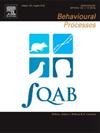The importance of color and body size for reproductive decision making by males and females of the giant river prawn, Macrobrachium rosenbergii (de Man, 1879) (Decapoda, Caridea, Palaemonidae)
IF 1.3
4区 生物学
Q4 BEHAVIORAL SCIENCES
引用次数: 0
Abstract
The selection and expression of conspicuous colorations in animals is often related to anti-predation strategies and sociosexual communication. The giant river prawn, Macrobrachium rosenbergii (de Man, 1879) is a species with three male morphotypes that vary in claws’ coloration and the size of the animals. It has been suggested that male reproductive quality might be associated to their coloration, but evidence is still conflicting. In addition, a possible communication function of orange patches, that occupies a large portion of egg-bearing females’ cephalothorax, has never been investigated before. For that matter, in this study, we evaluated the importance of visual cues for reproductive decision making by males and females of the giant river prawn. Through two-choice discrimination experiments, we verified whether: 1) females would be equally attracted to the presence of males expressing different claw colorations and body sizes; 2) female reproductive status and body size would influence males’ decision making. Under the tested experimental conditions, females predominantly chose larger over smaller males, while males showed no significant preference for any kind of female. It is possible that body size is one of the cues that females use to identify males’ morphotype. The choice of larger males could provide greater protection for females against harassment by other males. Further studies should employ visual cues in combination with chemical ones for a better understanding of mate choice in this species.
罗氏沼虾(十足目,鲤科,对虾科)雌雄对虾的生殖决策中颜色和体型的重要性(de Man, 1879)。
动物中显眼颜色的选择和表达通常与反捕食策略和社会性交流有关。罗氏巨虾(Macrobrachium rosenbergii, de Man, 1879)是一种有三种雄性形态的河虾,它们的爪子颜色和体型各不相同。有人认为男性的生殖质量可能与他们的颜色有关,但证据仍然相互矛盾。此外,占据产卵雌性头胸很大一部分的橙色斑块可能具有的交流功能,此前从未被研究过。因此,在本研究中,我们评估了视觉线索对雄性和雌性巨型河对虾生殖决策的重要性。通过双选择歧视实验,我们验证了:1)雌性是否会同样地被不同爪色和体型的雄性所吸引;2)女性生殖状态和体型会影响男性的决策。在测试的实验条件下,雌性倾向于选择体型较大的雄性而不是体型较小的雄性,而雄性对任何一种雌性都没有明显的偏好。体型可能是雌性用来识别雄性形态的线索之一。选择体型较大的雄性可以更好地保护雌性免受其他雄性的骚扰。为了更好地了解这个物种的配偶选择,进一步的研究应该将视觉线索与化学线索结合起来。
本文章由计算机程序翻译,如有差异,请以英文原文为准。
求助全文
约1分钟内获得全文
求助全文
来源期刊

Behavioural Processes
生物-动物学
CiteScore
2.70
自引率
7.70%
发文量
144
审稿时长
4-8 weeks
期刊介绍:
Behavioural Processes is dedicated to the publication of high-quality original research on animal behaviour from any theoretical perspective. It welcomes contributions that consider animal behaviour from behavioural analytic, cognitive, ethological, ecological and evolutionary points of view. This list is not intended to be exhaustive, and papers that integrate theory and methodology across disciplines are particularly welcome.
 求助内容:
求助内容: 应助结果提醒方式:
应助结果提醒方式:


